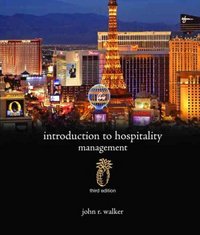Question
1. Satisficing is best defined as a.choosing the optimum solution to a problem. b.knowing all action alternatives and their consequences before making a decision. c.choosing
1. Satisficing is best defined as
a.choosing the optimum solution to a problem.
b.knowing all action alternatives and their consequences before making a decision.
c.choosing the first alternative that appears to give an acceptable resolution to a problem.
d.making a decision which satisfies all parties.
2. Barbara is the manager of a small regional airline whose primary customers are people travelling to a major city 300 kilometres away. A few months ago, she introduced a 'buy one ticket, get one free' promotion to increase air traffic to the city. The promotion was not significantly increasing traffic, primarily because the typical customers were business people who would have flown anyway and who were now bringing along an assistant or other business associate. The promotion was costing the company a lot of money, yet Barbara continued to offer it. Barbara's decision to continue the promotion despite negative feedback is called a(n):
a.escalation of commitment.
b.anchoring and adjustment heuristic.
c.programmed decision.
d.representativeness heuristic.
3. James developed a program that allowed salespeople to comment on new directives from the owner of the local car dealership and management. James quickly found that the sales staff became more responsive to the new instruction. Why?
a.Improved feedback
b.Improved communication channels
c.Reduction of noise
d.Increased formal communication channels
4. Planned communication connections between holders of the various positions within the organisation are called:
a.informal communication channels.
b.effective communication.
c.quasiformal channels.
d.formal communication channels.
5. Ria manages the fitness centre of a large hotel. Recently Lee Ann was hired as an exercise physiologist, even though Ria was opposed to the appointment, based on Lee Ann's weak academic record and lack of experience. Lee Ann found out about Ria's protests and has since been uncooperative and sullen at work. This is an example of which type of conflict?
a.process
b.intrapersonal
c.substantive
d.emotional
6. Which of the following best describes the difference between emotions and moods?
a.Emotions are longer lasting than moods.
b.Moods are more trait-like than emotions.
c.Emotions have a specific source whereas moods are more diffuse.
d.Moods have an affective component but moods do not.
7. Which of the following statements best describes the trend toward work intensification?
a.Stress is a less prevalent issue as employees have more balance between work and non-work.
b.Employees who are dedicated to their work feel less stress.
c.Workers tend to work longer hours and have more job demands.
d.Roles are becoming more clearly defined.
8. Dave sends Ken a series of 10 emails in one hour. In the middle is one email that needs urgent attention, and it is labelled 'High Importance'. Dave called Ken a week later to find out why the urgent matter had not been addressed. Why did Dave's request fail to catch the attention of Ken?
a.The message of the urgent email was clouded by the 'noise' of the other emails
b.The message was not clear
c.Ken could not decode the message
d.The message was too complex for Ken to understand
9.Communication which occurs at minimum cost in terms of resources expended is:
a.effective.
b.efficient.
c.biased.
d.normal.
10. Which decision theory views the manager as acting in a rational manner with complete information?
a.Satisficing
b.Managerial
c.Behavioural
d.Classical
Step by Step Solution
There are 3 Steps involved in it
Step: 1

Get Instant Access to Expert-Tailored Solutions
See step-by-step solutions with expert insights and AI powered tools for academic success
Step: 2

Step: 3

Ace Your Homework with AI
Get the answers you need in no time with our AI-driven, step-by-step assistance
Get Started


